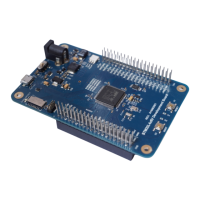DocID024597 Rev 3 189/1693
RM0351 Reset and clock control (RCC)
253
capability (LSEDRV=00) when the LSE is ON. However, once LSEDRV is selected, the
drive capability can not be increased if LSEON=1.
The LSERDY flag in the Backup domain control register (RCC_BDCR) indicates whether
the LSE crystal is stable or not. At startup, the LSE crystal output clock signal is not released
until this bit is set by hardware. An interrupt can be generated if enabled in the Clock
interrupt enable register (RCC_CIER).
External source (LSE bypass)
In this mode, an external clock source must be provided. It can have a frequency of up to
1 MHz. You select this mode by setting the LSEBYP and LSEON bits in the AHB1 peripheral
clocks enable in Sleep and Stop modes register (RCC_AHB1SMENR). The external clock
signal (square, sinus or triangle) with ~50 % duty cycle has to drive the OSC32_IN pin while
the OSC32_OUT pin can be used as GPIO. See Figure 13.
6.2.6 LSI clock
The LSI RC acts as a low-power clock source that can be kept running in Stop and Standby
mode for the independent watchdog (IWDG), RTC and LCD. The clock frequency is 32 kHz.
For more details, refer to the electrical characteristics section of the datasheets.
The LSI RC can be switched on and off using the LSION bit in the Control/status register
(RCC_CSR).
The LSIRDY flag in the Control/status register (RCC_CSR) indicates if the LSI oscillator is
stable or not. At startup, the clock is not released until this bit is set by hardware. An
interrupt can be generated if enabled in the Clock interrupt enable register (RCC_CIER).
6.2.7 System clock (SYSCLK) selection
Four different clock sources can be used to drive the system clock (SYSCLK):
• MSI oscillator
• HSI16 oscillator
• HSE oscillator
• PLL
The system clock maximum frequency is 80 MHz. After a system reset, the MSI oscillator, at
4 MHz, is selected as system clock. When a clock source is used directly or through the PLL
as a system clock, it is not possible to stop it.
A switch from one clock source to another occurs only if the target clock source is ready
(clock stable after startup delay or PLL locked). If a clock source which is not yet ready is
selected, the switch will occur when the clock source becomes ready. Status bits in the
Internal clock sources calibration register (RCC_ICSCR) indicate which clock(s) is (are)
ready and which clock is currently used as a system clock.
6.2.8 Clock source frequency versus voltage scaling
The following table gives the different clock source frequencies depending on the product
voltage range.

